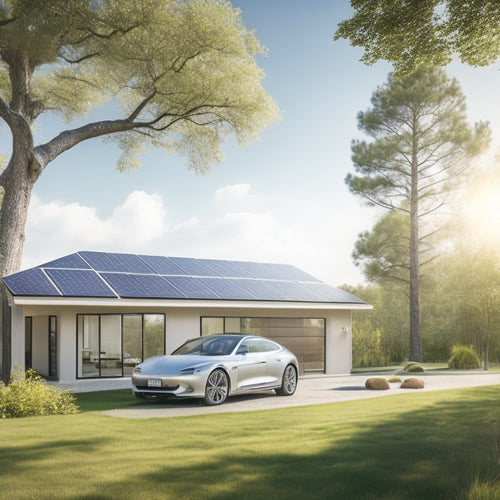
3 Essential Steps for Setting Up Solar Power
Share
To set up solar power, you'll need to assess your energy needs by calculating your daily energy consumption, considering solar irradiance, and determining your overall daily energy usage. Next, choose a solar panel system that meets your needs, selecting from monocrystalline, polycrystalline, or thin-film panels, and evaluating installation costs, efficiency rates, and warranty terms. Finally, install and connect your system, guaranteeing proper electrical connections, secure mounting, and peak performance. By following these essential steps, you'll be well on your way to utilizing the power of the sun - and there's even more to investigate to guarantee a seamless change.
Key Takeaways
- Calculate daily energy consumption by listing appliance wattage and usage hours to determine overall energy needs.
- Choose a suitable solar panel system based on efficiency rates, durability, and costs, considering installation and additional fees.
- Ensure proper installation, secure electrical connections, and compliance with local codes for peak performance and safety.
- Connect solar panels to an inverter for DC-to-AC power conversion and link to the electrical panel for home integration.
- Conduct final checks to confirm the system operates at maximum capacity and efficiency.
Assess Your Energy Needs
You'll need to determine how much energy your solar power system should produce to meet your needs. This requires calculating your daily energy consumption, which involves identifying the appliances and devices you want to power with solar energy.
Start by listing the wattage of each appliance and the number of hours you use them daily. Multiply these values to get the total watt-hours (Wh) consumed per day. Add up the Wh values to determine your total daily energy consumption.
Next, consider your location's solar irradiance, which affects the solar efficiency of your system. Irradiance varies by region, season, and time of day. You can use online tools or consult with a solar expert to determine the average daily irradiance in your area.
This value will help you determine the required solar panel capacity to meet your energy needs. By accurately evaluating your energy consumption and solar irradiance, you'll be able to design a solar power system that efficiently generates the energy you need.
Choose Your Solar Panel System
Having determined your daily energy consumption and assessed the impact of solar irradiance, it's time to select a solar panel system that meets your needs.
You'll need to choose from various solar panel types, including monocrystalline, polycrystalline, and thin-film panels. Each type has its own efficiency rate, durability, and cost. Monocrystalline panels are the most efficient but also the most expensive, while thin-film panels are less efficient but more affordable.
When selecting a system, evaluate the installation costs, including the cost of the panels, inverters, mounting hardware, and labor. The total cost will depend on the size of the system, installation complexity, and local labor rates.
You may also need to assess additional costs, such as permitting fees, inspections, and grid connection charges.
It's crucial to evaluate different system configurations and compare their performance, cost, and warranty terms. You may want to consult with a solar panel professional to determine the best system for your specific needs and budget.
Install and Connect Your System
Your solar panel system is now ready for installation, and it's essential to get it done correctly to guarantee peak performance and safety.
A well-executed system installation guarantees that your solar panels operate at their maximum capacity, providing you with the power you need.
During the connection process, you'll need to:
- Verify all electrical connections are secure and meet local electrical codes
- Connect the solar panels to the inverter, which converts DC power to AC power for your home
- Connect the inverter to your electrical panel, allowing the solar power to feed into your home's electrical system
Frequently Asked Questions
Can I Install Solar Panels on a Metal or Clay Tile Roof?
You'll need to assess your roof's suitability for solar panels; metal roofs require specialized mounting systems, while clay tiles can be fragile, so you'll need to guarantee the tiles are securely fastened and won't be damaged during installation.
Do Solar Panels Work During Power Outages or at Night?
You'll find that solar panels don't generate power during outages or at night, but you can still access energy with the right setup; consider energy storage options, like batteries, to store excess energy generated during the day for later use.
How Often Should I Clean My Solar Panels for Optimal Performance?
You'd be shocked how much dirt and debris can slash your solar panel efficiency by up to 25%! Clean them every 6 months to maintain peak performance, but if you're in a dusty area, ramp up your solar panel maintenance to every 3 months for ideal energy harvesting.
Are There Any Local or National Incentives for Going Solar?
You'll be pleased to know that you're eligible for federal tax credits, covering up to 26% of your solar installation costs, and potentially state rebates, which vary by location, to considerably reduce your investment in going solar.
Can I Add More Panels to My Existing Solar Panel System Later?
As you "chart your course" for sustainable energy, you're wondering if you can add more panels to your existing system later. Fortunately, yes, you can expand your system, but make certain new panels are compatible with your existing setup to maximize energy harvesting.
Related Posts
-

Why You Need a Phone Mount for Navigation
When you're on the road, a reliable phone mount is not just a convenience, it's a safety necessity that helps you mai...
-

Why Invest in Solar Car Battery Chargers Online?
By investing in a solar car battery charger online, you're not only reducing your reliance on fossil fuels but also o...
-

Why Invest in Residential Solar Panel Systems?
By investing in a residential solar panel system, you'll harness renewable energy, reducing your carbon footprint and...


